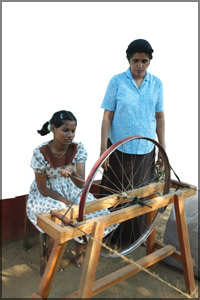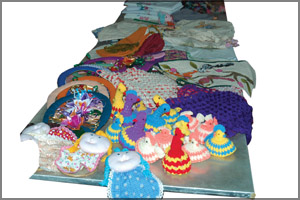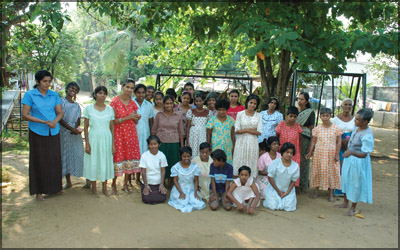Brighter tomorrow for the differently baled
‘...you’ll find that there’s no need to cry...’:
By Harshini PERERA
[email protected]
  Multicoloured
and various shaped wall hangers were hung on the eve of the 40th
anniversary of their Home, which fell on November, 8. Thirty seven girls
are resident in the Girl’s Home for the Differently-Abled, Katukurunda
and their ages range from 11 to 61. The bitter truth is that 19 of them
are orphans. Away from their homes, in Katukurunda, Moratuwa. Mrs. Ruby
De Mel, H.E.P. De Mel and a few other philanthropists from Moratuwa area
had founded this special home for the differently abled people in 1968.
Affiliated to the National Council for Child and Youth Welfare and
registered with the Department of Social Services, the National Council
for Child and Youth Welfare pays the approved nominal subsistence for
the sustenance of the children. Multicoloured
and various shaped wall hangers were hung on the eve of the 40th
anniversary of their Home, which fell on November, 8. Thirty seven girls
are resident in the Girl’s Home for the Differently-Abled, Katukurunda
and their ages range from 11 to 61. The bitter truth is that 19 of them
are orphans. Away from their homes, in Katukurunda, Moratuwa. Mrs. Ruby
De Mel, H.E.P. De Mel and a few other philanthropists from Moratuwa area
had founded this special home for the differently abled people in 1968.
Affiliated to the National Council for Child and Youth Welfare and
registered with the Department of Social Services, the National Council
for Child and Youth Welfare pays the approved nominal subsistence for
the sustenance of the children.
Every human is special and their abilities should be recognized and
appreciated for what they are. I would say, that the visit to the Home,
was a kind of journey back to humanity, which the man has forgotten.
People who are differently abled too belong our society, but
unfortunately are sometimes discriminated as a group of useless
individuals.
Former honorary warden, Ranjanie Mendis, recalling the past,
mentioned how it all began for her when she started rehabilitating
children from the adjoining old building.” It had been a laborious task
to train them which we have achieved to a great extent. An Irish lady -
Ms. Katherine Willies - enlightened me, she pointed out that these
children could be trained with love and care, which led us to build a
new rehabilitation centre. Their art and creations depict the great
transformation they had undergone at the rehabilitation centre.”
The creative wall hangers, woollen mats, various patterned coir mats
and ropes they have done are exquisite. The children were able to
receive gold, silver and bronze medals at international art exhibitions
for the differently abled, held in Taiwan, 1998 which was a milestone of
their achievements. Their abilities were exhibited not only through art
work, but also in cooking, maintenance of toilets, cleaning dormitories,
etc. The girls were divided into high and low grades where the lower
graders were guided by three teachers and given basic training as in
different ways to understand colours, numbers and shapes.
When the Sunday Observer spoke to Udaya Ranatunga, Senior
Administrative Officer of National Council for Child and Youth Welfare (NCCYW),
their concern for the differently abled became evident. There are seven
homes for child and youth welfare, three homes for the differently abled
- two for boys in Madiwela and Lewella, and other in Katukurunda, for
girls. Four more orphanages in Wennappuwa, Pamunugama, Wattegama and
Godakawela are also run by the National Council for Child and Youth
Welfare.
The program for the differently abled and orphans was started in the
hope of inculcating the belief that children suffering from disability
have their rights for the due share of love, care and protection. This
was founded away back in 1954 by late Albert Peiris, Lady Evelyn Soyza,
Dr. L.O. Abeyaratne, Dr. Mary Ratnam, Sita Seneviratna, as a government
approved charity.
Protection of children, instilling in them the confidence, ability to
work on their own and education were their main objectives. While giving
them a good education, some orphanages have vocational training
programmes as well, under which they conduct courses in computer
studies, weaving and the differently abled children handicraft, coir
making etc. The Council attempts to improve the children’s lives,
through a sound education and thereby produce good citizens. For this
purpose have been provided with good lecturers. Some visit the homes
regularly and some, twice a week.
Malkanthi Perera, as a child grew up in a girl’s home for the
differently abled in Katukurunda. She was a high grader and despite her
handicap, was able to get employment at a marshmellow factory. Music
plays a crucial role in their lives.
They respond to light and music and also engage in dancing. Girls who
cannot contribute to other activities show a particular talent in music.
Much to their physical well being sportsmeets, concerts and camps have
been organized. On the day of their exhibition and sale, much prominence
will be given to their creativity and is hoped that their hard work will
create awareness among people, of their amazing abilities. These women
yearn to be loved and cared.
A stroke of the head with love and kindness would count a lot to
them. Much for my admiration they are not a disabled group of people,
but differently abled in the true sense of the word. They are also human
beings, who feel as we do and enjoy life as they can.
 |

